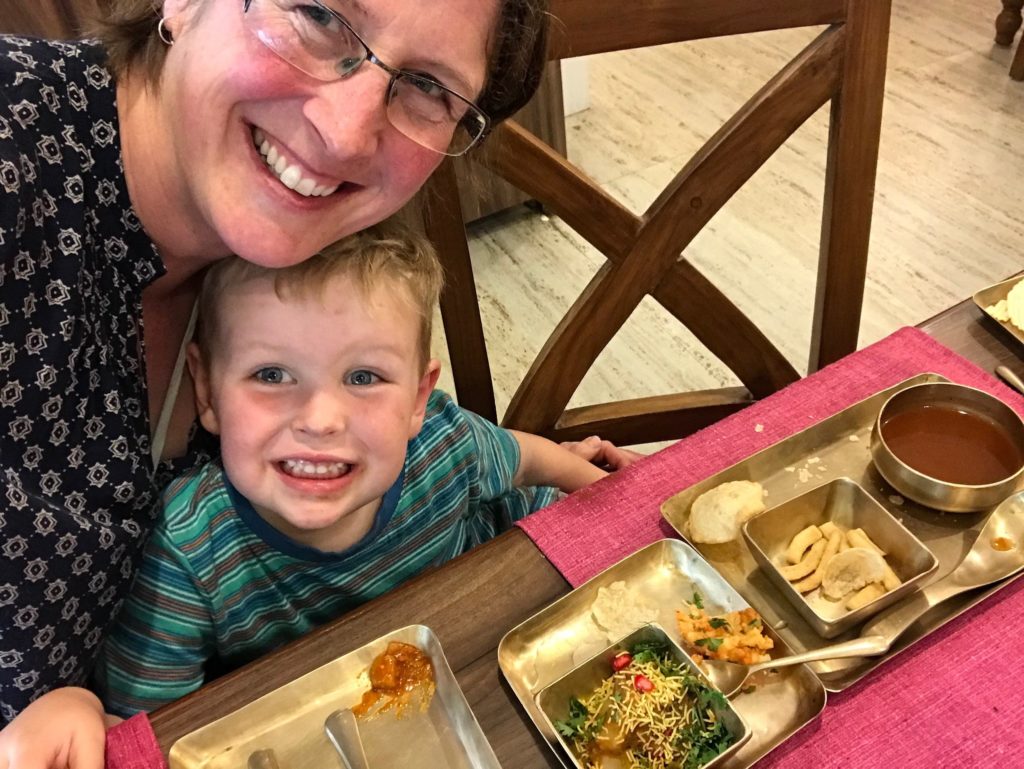Feeding kids in a foreign country: How I made overseas travel work for my picky eater.
Erica Noble is a teacher, Mum and Family Food Educator, based in Tasmania I invited her to share her insights from a recent trip to India, after she posted about it in Parenting Picky Eaters, the Facebook group I co-run with Simone Emery. I’m sure you’ll enjoy reading about Erica’s experiences as much as I did.
Our family have recently returned from a month living in India. Our boys are 3 and 5 and feeding them while we were away was certainly not without challenges.
But, with some clear strategies in place, the kids surprised even me with how well they coped in such an unfamiliar eating environment. They tried many new foods and mealtimes were generally an enjoyable family experience.
So many learns. For the kids and for me! I hope this post can inspire others to take the plunge and embrace all that overseas travel has to offer… even if you have a picky eater.
Our 3yo has always been cautions with food and is still very much in the neophobic phase. He strongly asserts his independence (“No!”, or “I do it!”) and often uses the ubiquitous codeword “yuk” to mean “too different”, “smells funny”, “I don’t know what’s in that” or “I don’t know how to eat that”.
Our 5yo has sensory processing difficulties which means he has a small sensory cup for certain visual input, sounds, touch, smells and textures. He can become overwhelmed quickly and can have sensory meltdowns.
India is country aptly described as an “assault on the senses” – a cacophony of noises, big smells, discordant sounds and strong flavours. Not to mention the visual assault of vibrant colours, dirt, rubbish, people and vehicles. Picture my two boys in this environment! You get it 😊
Three main things saved my bacon (pun intended… haha!).
1. Laying the foundations
We have been following Ellyn Satter’s Division of Responsibility (DOR) for almost two years now. Switching to DOR and family style serving has involved a mindset shift but we’re in a regular routine now; it’s just how we do things. The kids know the drill. They don’t need to “eat x, y or z” or “eat a certain amount”, but they do need to come to the table. They know that there is one meal for everyone and trust there will be something on the table they can eat. They feel comfortable serving themselves what they want from the food on offer in the middle of the table.
We have come to embrace progress not perfection.
2. Mealtime strategies in India
So many unrecognisable foods! Ordering a few dishes for everyone to share and serving them family style greatly reduced anxiety and overwhelm. Among the new, I made sure that there were also familiar and sort-of-familiar foods. That way the kids could still come to the table knowing there was something they could eat. For my boys, this meant plain rice, simple rice dishes e.g. biryani, some sort of crisp/chip/fries, plain bread (e.g. bread sticks, naan, chapati, roti etc.), yoghurt and yogurt-based side dishes such as lassi or raita, fruit, veggie sticks and condiments e.g. tomato sauce.
This no-pressure approach went a long way to reducing everyone’s stress. The boys were confident trying new foods at their own pace and both my husband and I were amazed at what they tried. Chicken lollipops are now a new favourite food – a sensory minefield (crispy, sticky and soft all at the same time), garnished with coriander and a hefty dose of chilli!
Bread sticks or triangles of flatbread and naan were great as familiar “dippers” to try new curries, soups and condiments. Talking about what they already know helped them try many “almost familiar foods” e.g. “chapati, roti and paratha are like the wraps we have at home”.
Giving them an “out” and providing strategies to get out of sensory trouble increased their confidence trying new foods e.g. “Here’s a serviette, you can just politely spit it out if you don’t want to swallow it”, “That one is quite sticky, here’s a cloth if you need to wipe your fingers” or “This one is a bit more like soup, would it help to put it in a bowl or use your bread to dip with?”.
Using all the senses, descriptive language and role-modelling helped to de-mystify unfamiliar food. E.g. “This one is very crunchy”, “I can break this open and see what’s inside”, “This cheese is orange, the cheese at home is white”, “That one does have a strong smell, doesn’t it?”, “This one is very mild”, or “If the flavour of that one is too strong in your mouth, this one has some yogurt which will help the chilli feeling”. Our 3yo even started copying the language we used…. “Daddy, this one is quite spicy, be careful!”.
Providing opportunities for the kids to interact with food away from the table gave valuable exposure. We wandered up and down markets, learned how to grind fresh coconut, watched people make dosa and found a kid’s picture book with all the vegetables we were unable to identify!
3. An emergency response protocol
Despite best laid plans, sometimes meals still went pear-shaped! The kids were either too tired, too overstimulated, hadn’t had enough physical activity or were just too “something else”!
To the rescue: relax, deep breaths, take a break, have a reset cuddle and find my son’s sensory calming blanket 😊
Overall, it was fabulous trip. The kids even started to develop quite a chilli palate! Since we’ve been back they have retained their culinary adventurous spirit and I’m looking forward to making curries and to stepping out of my comfort zone more with family meals.

